Doug and Dave walk the Camino de Santiago
Day 2, Friday, April 13, 2007
Rabanal -to- Acebo
 Distance travelled today: 17.0 km, 10.6 mi
Distance travelled today: 17.0 km, 10.6 mi  Total distance walked: 38.4 km, 23.9 mi
Total distance walked: 38.4 km, 23.9 mi  Distance to Santiago: 232.6 km, 144.5 mi
Distance to Santiago: 232.6 km, 144.5 mi 

 We started the climb this day to the highest point we encountered on the Camino,
to La Cruz de Ferro at 1,505 m (4,958 ft). It was not the steepest climb, which
came on Day 6.
The photos here were near Foncebadón looking south and west to the snow covered,
7,200 ft Montañas de León (León mountain range).
We did not foresee how high, or in what type of terrain we would be!
We started the climb this day to the highest point we encountered on the Camino,
to La Cruz de Ferro at 1,505 m (4,958 ft). It was not the steepest climb, which
came on Day 6.
The photos here were near Foncebadón looking south and west to the snow covered,
7,200 ft Montañas de León (León mountain range).
We did not foresee how high, or in what type of terrain we would be!
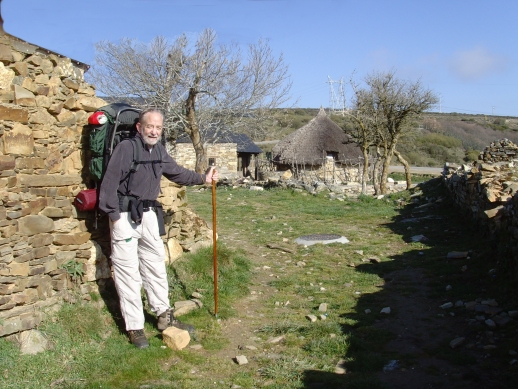 We made a quick stop at this farmhouse near Foncebadón to take a photo of the
thatched roof building, a palloza, which seems to be used for grain or animals.
We made a quick stop at this farmhouse near Foncebadón to take a photo of the
thatched roof building, a palloza, which seems to be used for grain or animals.
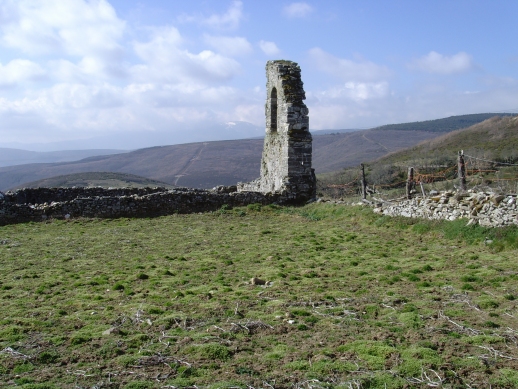
 These ruins are the remains of church and simple pilgrim hospital built in the
12th century by the hermit Gaucelmo. On the right is a view back toward the ruins.
These ruins are the remains of church and simple pilgrim hospital built in the
12th century by the hermit Gaucelmo. On the right is a view back toward the ruins.
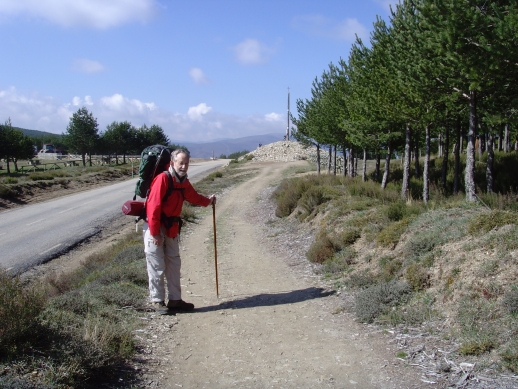
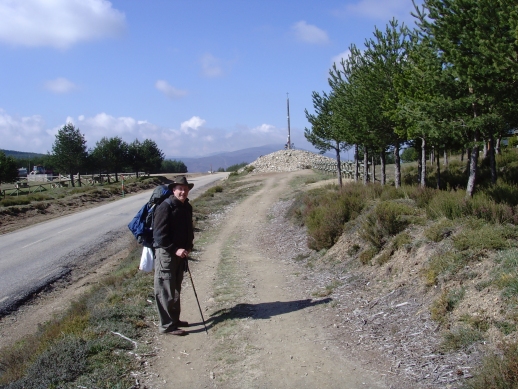 Here we are approaching the summit at the Cruz de Ferro (Cross of Iron). This simple
icon is one of the abiding symbols of the Camino. Pilgrims have passed through here
over 1200 years. It has become a tradition for pilgrims to leave a stone on the pile
below the Cruz, preferably from home.
Here we are approaching the summit at the Cruz de Ferro (Cross of Iron). This simple
icon is one of the abiding symbols of the Camino. Pilgrims have passed through here
over 1200 years. It has become a tradition for pilgrims to leave a stone on the pile
below the Cruz, preferably from home.
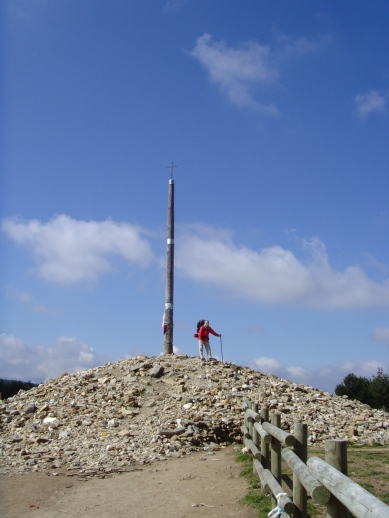
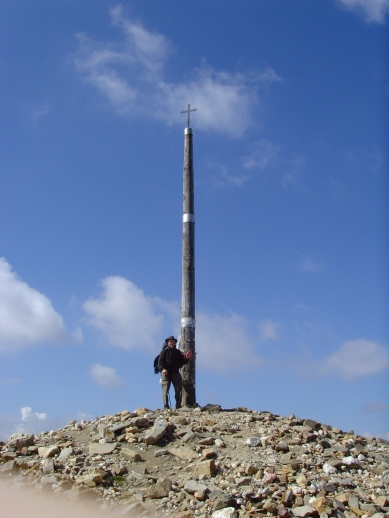 Doug and Dave on the rock pile at Cruz de Ferro.
Doug and Dave on the rock pile at Cruz de Ferro.

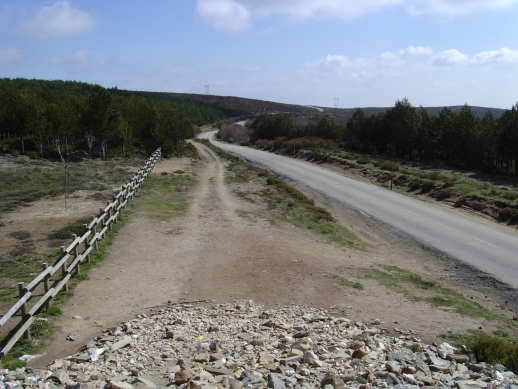 Looking forward (left) and backward (right) on the Camino from the Cruz de Ferro.
Looking forward (left) and backward (right) on the Camino from the Cruz de Ferro.
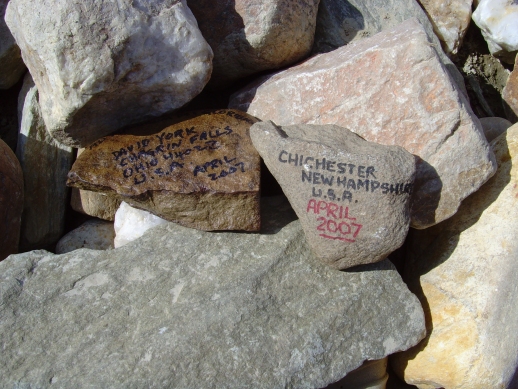 Doug's and Dave's rocks from home on the rock pile at Cruz de Ferro.
Doug's and Dave's rocks from home on the rock pile at Cruz de Ferro.
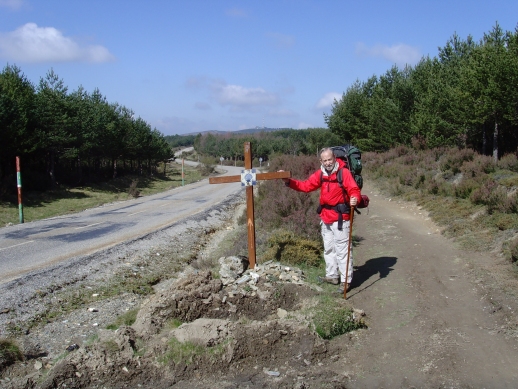
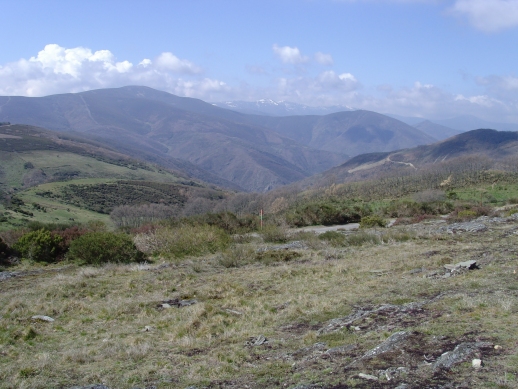 Doug a few meters down the Camino from Cruz de Ferro by a cross made from box steel.
On right, view down the Camino from near the town of Manjarín.
Notice the snow covered Mountains of León in the background.
Doug a few meters down the Camino from Cruz de Ferro by a cross made from box steel.
On right, view down the Camino from near the town of Manjarín.
Notice the snow covered Mountains of León in the background.
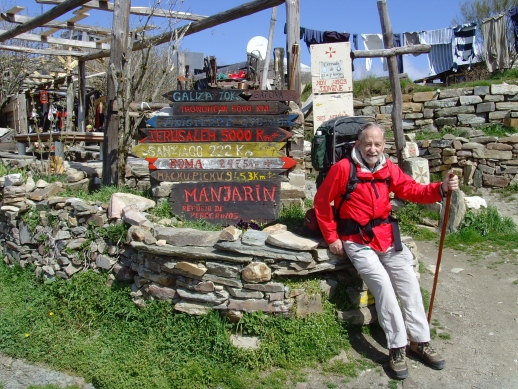
 This is a not-to-be-missed stop on the Camino; the only occupied house in the
abandoned village of Manjarín. The albergue is run by Tomás, a man commited to the
welfare of pilgrims. He is a modern Knight Templar. He rings a bell for each pilgrim
on the Camino. He performs the blessing of the new day, an old Templar ritual, and plays
Taizé music in the form of Gregorian chants. The Spanish government once tried to evict
him by turning off his electricity, but he went on a hunger strike that caught the
attention of the media. The government backed down.
This is a not-to-be-missed stop on the Camino; the only occupied house in the
abandoned village of Manjarín. The albergue is run by Tomás, a man commited to the
welfare of pilgrims. He is a modern Knight Templar. He rings a bell for each pilgrim
on the Camino. He performs the blessing of the new day, an old Templar ritual, and plays
Taizé music in the form of Gregorian chants. The Spanish government once tried to evict
him by turning off his electricity, but he went on a hunger strike that caught the
attention of the media. The government backed down.
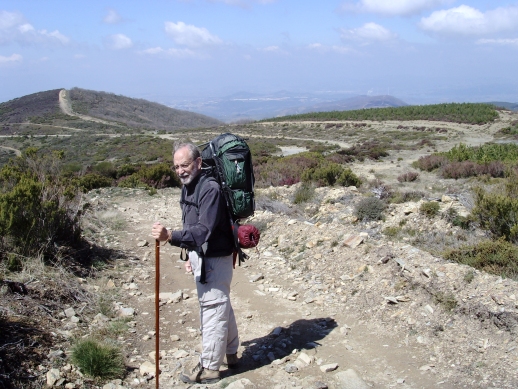
 Doug and Dave near Punto Alto, beautiful views of the area from this point!
Doug and Dave near Punto Alto, beautiful views of the area from this point!
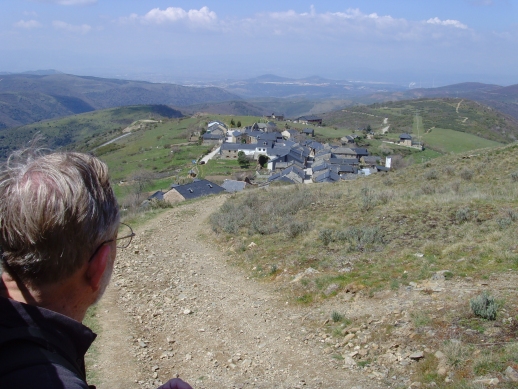
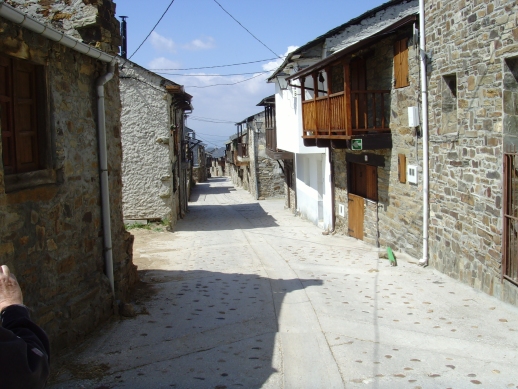 Doug looks down on the town of Acebo where we will spend the night. On the right,
is a view down the main street of Acebo. Notice the balcony construction typical
of mountain towns in this area.
The streets are designed so that the rain water flows down the center of the street.
Doug looks down on the town of Acebo where we will spend the night. On the right,
is a view down the main street of Acebo. Notice the balcony construction typical
of mountain towns in this area.
The streets are designed so that the rain water flows down the center of the street.
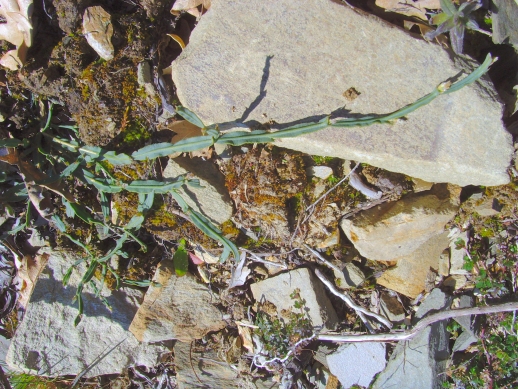
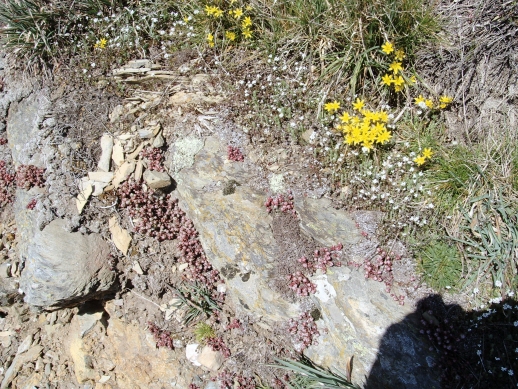 Plant life along the Camino. On the left is some type of cactus which grows only at the
higher elevations; on the right are yellow flowers and interesting mosses and fungi.
Plant life along the Camino. On the left is some type of cactus which grows only at the
higher elevations; on the right are yellow flowers and interesting mosses and fungi.
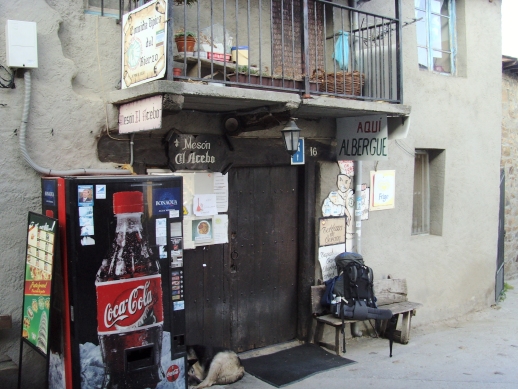
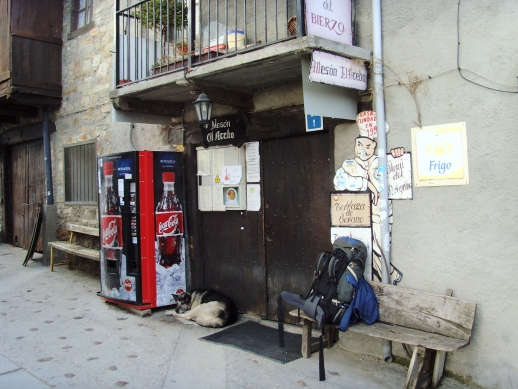 The front of the albergue, Mesón El Acebo, where we stayed on Friday night.
The front of the albergue, Mesón El Acebo, where we stayed on Friday night.
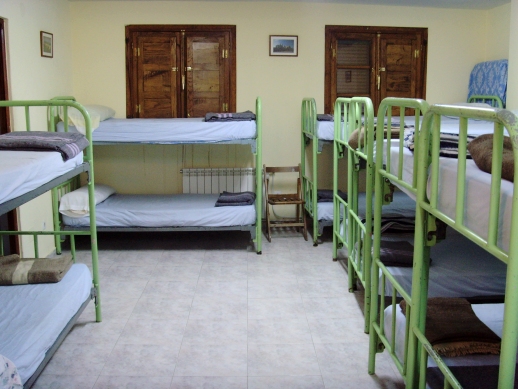
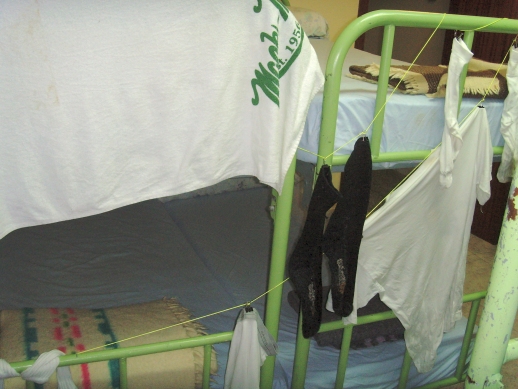 Inside the albergue, typical of most albergues, except we were the only residents!
Dave's laundry is drying on the right. What happens in the summer when the place
is full and everyone has wet clothes?!
Inside the albergue, typical of most albergues, except we were the only residents!
Dave's laundry is drying on the right. What happens in the summer when the place
is full and everyone has wet clothes?!
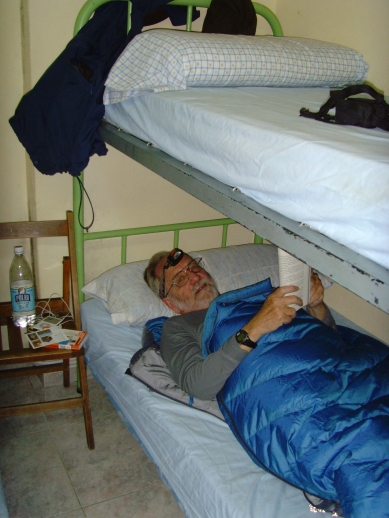 Doug, with his reading lamp and a book, rests in his sleeping bag in the bunk bed.
Doug, with his reading lamp and a book, rests in his sleeping bag in the bunk bed.
 Distance travelled today: 17.0 km, 10.6 mi
Distance travelled today: 17.0 km, 10.6 mi  Total distance walked: 38.4 km, 23.9 mi
Total distance walked: 38.4 km, 23.9 mi  Distance to Santiago: 232.6 km, 144.5 mi
Distance to Santiago: 232.6 km, 144.5 mi 


We started the climb this day to the highest point we encountered on the Camino, to La Cruz de Ferro at 1,505 m (4,958 ft). It was not the steepest climb, which came on Day 6. The photos here were near Foncebadón looking south and west to the snow covered, 7,200 ft Montañas de León (León mountain range). We did not foresee how high, or in what type of terrain we would be!
We made a quick stop at this farmhouse near Foncebadón to take a photo of the thatched roof building, a palloza, which seems to be used for grain or animals.

These ruins are the remains of church and simple pilgrim hospital built in the 12th century by the hermit Gaucelmo. On the right is a view back toward the ruins.

Here we are approaching the summit at the Cruz de Ferro (Cross of Iron). This simple icon is one of the abiding symbols of the Camino. Pilgrims have passed through here over 1200 years. It has become a tradition for pilgrims to leave a stone on the pile below the Cruz, preferably from home.

Doug and Dave on the rock pile at Cruz de Ferro.

Looking forward (left) and backward (right) on the Camino from the Cruz de Ferro.
Doug's and Dave's rocks from home on the rock pile at Cruz de Ferro.

Doug a few meters down the Camino from Cruz de Ferro by a cross made from box steel. On right, view down the Camino from near the town of Manjarín. Notice the snow covered Mountains of León in the background.

This is a not-to-be-missed stop on the Camino; the only occupied house in the abandoned village of Manjarín. The albergue is run by Tomás, a man commited to the welfare of pilgrims. He is a modern Knight Templar. He rings a bell for each pilgrim on the Camino. He performs the blessing of the new day, an old Templar ritual, and plays Taizé music in the form of Gregorian chants. The Spanish government once tried to evict him by turning off his electricity, but he went on a hunger strike that caught the attention of the media. The government backed down.

Doug and Dave near Punto Alto, beautiful views of the area from this point!

Doug looks down on the town of Acebo where we will spend the night. On the right, is a view down the main street of Acebo. Notice the balcony construction typical of mountain towns in this area. The streets are designed so that the rain water flows down the center of the street.

Plant life along the Camino. On the left is some type of cactus which grows only at the higher elevations; on the right are yellow flowers and interesting mosses and fungi.

The front of the albergue, Mesón El Acebo, where we stayed on Friday night.

Inside the albergue, typical of most albergues, except we were the only residents! Dave's laundry is drying on the right. What happens in the summer when the place is full and everyone has wet clothes?!
Doug, with his reading lamp and a book, rests in his sleeping bag in the bunk bed.

Return to photo index